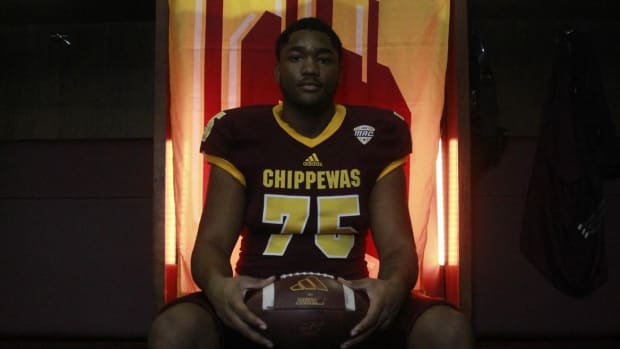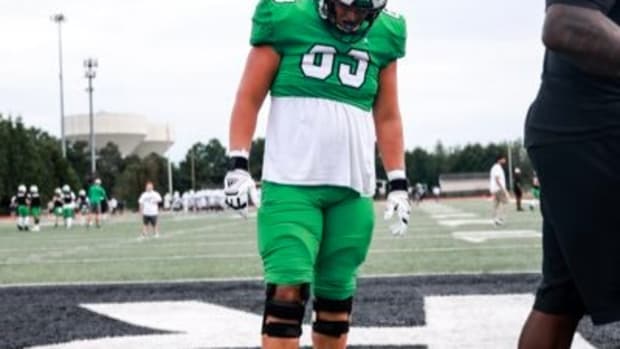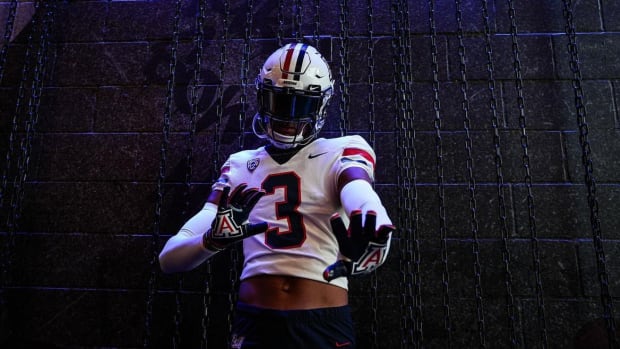78 Days Until Kansas Football: Big 12 Conference Scheduling Roundtable
This week on the countdown, we've been looking at what the scheduling might look like as the Big 12 membership changes in the next few seasons. On Sunday we talked about how the changes to the conference makeup would affect the Jayhawks. On Monday, I argued against divisions for the new conference. On Wednesday, I outlined some alternatives to the divisional model.
Today, I pulled the Blue Wings Rising crew together to get everyone's opinions on what the conference should do. Sure, the conference didn't really ask for our opinions. But we are going to give them anyway.
So take a look at what we all have to say below, and make sure to share your own thoughts on these questions over on the Discord server or by reaching out to our Twitter account.
With the Big 12 expanding to 14 teams for the 2023 season, which scheduling model do you think they should use (divisions, pods, protected rivalries, something else)?
Kyle Davis: The 14-team challenge is only going to be for one year, so my first answer is the league shouldn’t put too much effort into a model for 14 teams that it won’t then use for the 12 remaining in 2024. For next year, just be petty and stack the deck against Texas and Oklahoma to give them the toughest draws and then go from there.
When we’re back to 12, I am not feeling divisions or pods, and understand the desire for protected rivalries, so I would go with that. In football, you have 11 conference opponents and only nine league games. So, have three protected rivalries and then you have eight remaining potential Big 12 opponents for six game spots. That means you would play each remaining school twice in a three-year span.
Derek Noll: Three divisions. Two with the 12 teams that currently want to be in the conference, and one division with Texas and Oklahoma where they play each other 9 times or something. You want out? Fine, here is your punishment.
But seriously, two divisions for this year and beyond. But for this year, create a cool “made for TV” show where they pick opponents out of the hat to determine the other three league games for each team. Kind of like a Champions League draw or something like that. Could have a big name rep from each school show up to the draw and be the official person who gets to pull a ball out of the spinning lottery hopper. Would be a neat way to promote things.
Brendan Dzwierzynski: I don’t necessarily hate divisional models, although with either 12 or 14 teams there isn’t a split that makes much geographic sense for the new Big 12, and I’m all the way out on a “Leaders and Legends” scenario.
I think the best option is to guarantee protected rivalries and to make the Big 12 Championship Game still a matchup of the teams with the best records. Whether its 2 or 3 protected games annually, I think that’s the best way to guarantee meaningful matchups for programs and fans alike. Rivalries are the lifeblood of college football and we should at least keep those alive.
Andy Mitts: Early indications from what I’m hearing is that there are multiple schools that want divisions because they want to have the maximum number of games against guaranteed opponents each season. While that might make sense if there was a huge number of schools that had traditionally played each other every season or there were multiple tight geographic groupings, then it would make sense. But this is probably the most disbursed conference in the nation, spanning three time zones. And there are literally only 4 schools (Kansas, Kansas State, Iowa State and Oklahoma State) that have been in the same conference for the last 30 years.
I think pods could make sense if they were done correctly, but no matter what setup you use, you are going to have one awkward grouping. BYU would probably need to be with Kansas, Kansas State and Iowa State, but then that means you would have Oklahoma State paired with West Virginia, Cincinnati and UCF. You could swap a school here or there, but it doesn’t change the fact that WVU, Cincinnati and UCF are going to have one more pod member, unless you try to go with 4 pods. But that would get even more complicated.
Ultimately, I think the protected rivalries model is the way to go. It gives the maximum flexibility while still retaining super important rivalries. And for schools that don’t already have the number of rivals picked, it gives a great opportunity to start building some rivalries with certain schools.
If the Big 12 goes protected rivalries, how many should they protect each season, and which teams should be the protected rivals for Kansas?
Kyle Davis: Well, my math made it so three works with the format I suggested, so I’m sticking with that. K-State and Iowa State make the most sense from an actual rivalry standpoint and because of location. For the third, you could make an argument for Oklahoma State, Baylor, or maybe Texas Tech. The history of the Big Eight makes me lean Oklahoma State, but I could see a strong argument for Baylor given the basketball status.
Derek Noll: I like three as well because Kansas is running out of actual rivals. It’s all gonna be made up anyway when these new teams are added, creating fake rivalries and so on, so I’ll go with K-State, Iowa State, and Oklahoma State for KU.
Brendan Dzwierzynski: No disagreement from me on the number, I think three is the best option. K-State and Iowa State should be givens, and I would probably lean with Oklahoma State for No. 3 since the Jayhawks and Cowboys have been in the same conference for 60+ years and I like continuing that history. TCU doesn’t make a lot of sense but is my dark horse pick because for whatever reason KU has played plenty of close games against them in particular over the last decade.
Andy Mitts: For the sake of being different, I’m going to say go with 2. Kansas really only has one true rival in Kansas State, but Iowa State could easily be slotted in as the second one. No matter what you do, West Virginia, UCF and BYU are going to struggle to fill out their rivalry spots, so the less spots we make, the easier it is to fill them. If we did go with three, I would actually lean more towards Cincinnati or BYU as the third rival instead of Oklahoma State. Geographically it makes more sense, and the new schools will need to have some closer rivals. Kansas is closer to both of those schools than most of the others.
Join the discussion! Come talk about this or any of our articles on the Blue Wing Rising Discord Server.
Follow Blue Wings Rising on Twitter.
Listen to the official podcast of Blue Wings Rising: The Rock Chalk Podcast.



